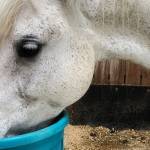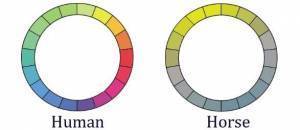Color Preferences Among Horses

Is it possible horses have color preferences? Does your palomino prefer purple, your Trakehner turquoise, your mare mauve? Can horse owners ever know?
Researchers recently explored color preferences through the use of different colored water buckets.1 Preference was determined based on how much water was consumed from galvanized steel buckets painted one of six colors: red, yellow, green, light green, light blue, and turquoise.

The approximate colors used in this color preference study.
Six horses, three Thoroughbreds and three Haflingers, were maintained on the same diet throughout the study (1-2 kg of forage, 0.5-1 kg concentrate per 100 kg of body weight). They were turned out in paddocks each day for seven hours for the duration of the study period, which lasted 18 days. Six buckets, one in each of the six colors, were attached to the fence equidistant from one another, about two meters. Researchers shifted bucket positions each day so that every bucket was in every position along the fence.
Based on water intake, researchers found that horses preferred to drink from the turquoise buckets. Preferences for the colors, from highest to lowest, were turquoise, light blue, light green, green, yellow, and red. Horses chose the blues over other colors and light-toned colors over darker tones.
In light of these results, the researchers suggested that the use of turquoise or light blue buckets might encourage horses to drink.
How Horses Perceive Color, Simply Put
Behavioral studies have demonstrated the ability of horses to discriminate colors. Like most other nonprimate mammals, horses are thought to have dichromatic color vision. Humans have trichromatic color vision and can see the four basic hues of red, green, blue, and yellow as well as an array of intermediate hues, like orange (yellowish-red) or violet (reddish-blue), and thousands of shades.
Scientists believe that horses and other animals with dichromatic vision do not process intermediate hues, seeing only shades of blue and yellow.
 The spectrum of colors perceived by humans with trichromatic color vision (left) and the same spectrum as viewed by horses (right), which are thought to have dichromatic color vision.2
The spectrum of colors perceived by humans with trichromatic color vision (left) and the same spectrum as viewed by horses (right), which are thought to have dichromatic color vision.2
1Yildirim, F., and A. Yildiz. 2020. Water bucket colour preferences in horses. Australia Journal of Veterinary Sciences 52(2).
2Carroll, J., C.J. Murphy, M. Neitz, J.N. Ver Hoeve, and J. Neitz. 2001. Photopigment basis for dichromatic color vision in the horse. Journal of Vision 1:80-87.








